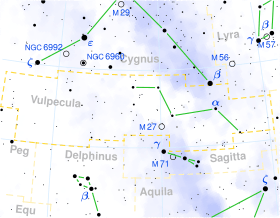9 Vulpeculae
| Observation data Epoch J2000 Equinox J2000 | |
|---|---|
| Constellation | Vulpecula |
| Right ascension | 19h 34m 34.89569s[1] |
| Declination | 19° 46′ 24.2462″[1] |
| Apparent magnitude (V) | 5.00[2] |
| Characteristics | |
| Spectral type | B8IIIn[3] |
| U−B color index | -0.43[2] |
| B−V color index | -0.09[2] |
| Astrometry | |
| Radial velocity (Rv) | +5.00[4] km/s |
| Proper motion (μ) | RA: +12.29[1] mas/yr Dec.: +1.73[1] mas/yr |
| Parallax (π) | 5.90 ± 0.23[1] mas |
| Distance | 550 ± 20 ly (169 ± 7 pc) |
| Absolute magnitude (MV) | -1.14[5] |
| Details | |
| Luminosity | 431[5] L☉ |
| Temperature | 10,917[6] K |
| Metallicity [Fe/H] | 0.00[7] dex |
| Rotational velocity (v sin i) | 185[8] km/s |
| Other designations | |
| Database references | |
| SIMBAD | data |
9 Vulpeculae is a class B8III[5] (blue giant) star in the constellation Vulpecula. Its apparent magnitude is 5.00[2] and it is approximately 550 light years away based on parallax.[1]
It has two reported distant companions, B, with a separation of 9.3" and magnitude 13.4, and C, with a separation of 108" and a magnitude of 12.5".[9][3] It is also a suspected variable star.[10]
References
- 1 2 3 4 5 6 Van Leeuwen, F. (2007). "Validation of the new Hipparcos reduction". Astronomy and Astrophysics. 474 (2): 653. arXiv:0708.1752
 . Bibcode:2007A&A...474..653V. doi:10.1051/0004-6361:20078357. Vizier catalog entry
. Bibcode:2007A&A...474..653V. doi:10.1051/0004-6361:20078357. Vizier catalog entry - 1 2 3 4 Ducati, J. R. (2002). "VizieR Online Data Catalog: Catalogue of Stellar Photometry in Johnson's 11-color system". CDS/ADC Collection of Electronic Catalogues. 2237. Bibcode:2002yCat.2237....0D.
- 1 2 Mason, Brian D.; Wycoff, Gary L.; Hartkopf, William I.; Douglass, Geoffrey G.; Worley, Charles E. (2001). "The 2001 US Naval Observatory Double Star CD-ROM. I. The Washington Double Star Catalog". The Astronomical Journal. 122 (6): 3466. Bibcode:2001AJ....122.3466M. doi:10.1086/323920. Vizier catalog entry
- ↑ Gontcharov, G. A. (2006). "Pulkovo Compilation of Radial Velocities for 35 495 Hipparcos stars in a common system". Astronomy Letters. 32 (11): 759. Bibcode:2006AstL...32..759G. doi:10.1134/S1063773706110065.
- 1 2 3 Anderson, E.; Francis, Ch. (2012). "XHIP: An extended hipparcos compilation". Astronomy Letters. 38 (5): 331. arXiv:1108.4971
 . Bibcode:2012AstL...38..331A. doi:10.1134/S1063773712050015. Vizier catalog entry
. Bibcode:2012AstL...38..331A. doi:10.1134/S1063773712050015. Vizier catalog entry - ↑ McDonald, I.; Zijlstra, A. A.; Boyer, M. L. (2012). "Fundamental parameters and infrared excesses of Hipparcos stars". Monthly Notices of the Royal Astronomical Society. 427: 343. Bibcode:2012MNRAS.427..343M. doi:10.1111/j.1365-2966.2012.21873.x. Vizier catalog entry
- ↑ Gontcharov, G. A. (2012). "Dependence of kinematics on the age of stars in the solar neighborhood". Astronomy Letters. 38 (12): 771. arXiv:1606.08814
 . Bibcode:2012AstL...38..771G. doi:10.1134/S1063773712120031. Vizier catalog entry
. Bibcode:2012AstL...38..771G. doi:10.1134/S1063773712120031. Vizier catalog entry - ↑ Abt, Helmut A.; Levato, Hugo; Grosso, Monica (2002). "Rotational Velocities of B Stars". The Astrophysical Journal. 573: 359. Bibcode:2002ApJ...573..359A. doi:10.1086/340590.
- ↑ Dommanget, J.; Nys, O. (2002). "VizieR Online Data Catalog: CCDM (Catalog of Components of Double & Multiple stars) (Dommanget+ 2002)". VizieR On-line Data Catalog: I/274. Originally published in: Observations et Travaux 54. 1274. Bibcode:2002yCat.1274....0D. Vizier catalog entry
- ↑ Samus, N. N.; Durlevich, O. V.; et al. (2009). "VizieR Online Data Catalog: General Catalogue of Variable Stars (Samus+ 2007-2013)". VizieR On-line Data Catalog: B/gcvs. Originally published in: 2009yCat....102025S. 1. Bibcode:2009yCat....1.2025S.
This article is issued from Wikipedia - version of the 9/3/2016. The text is available under the Creative Commons Attribution/Share Alike but additional terms may apply for the media files.
